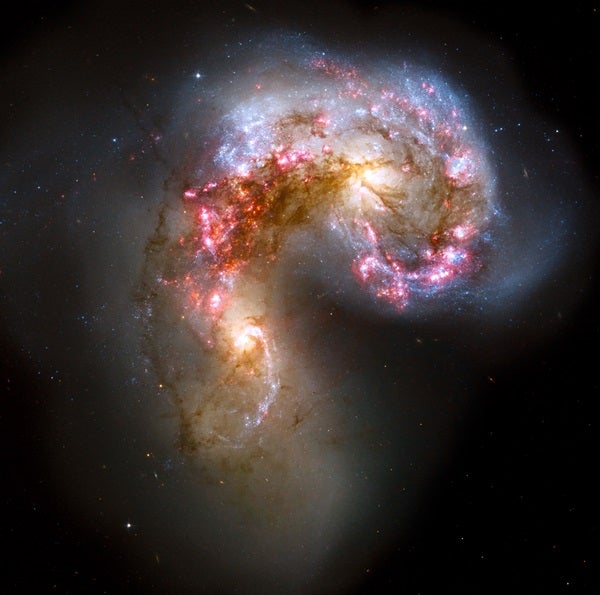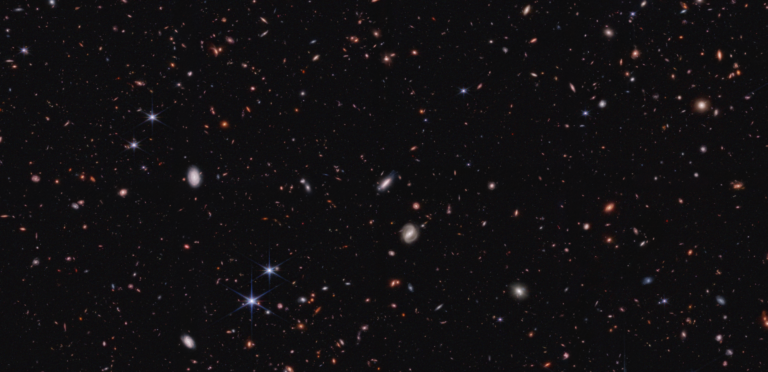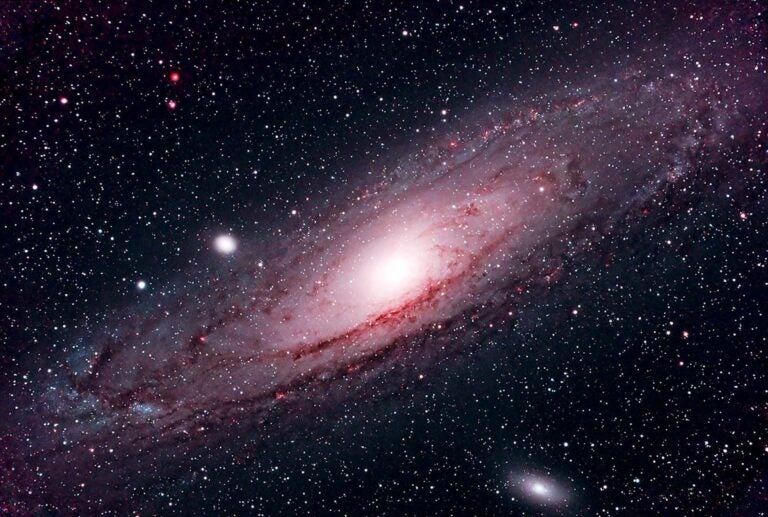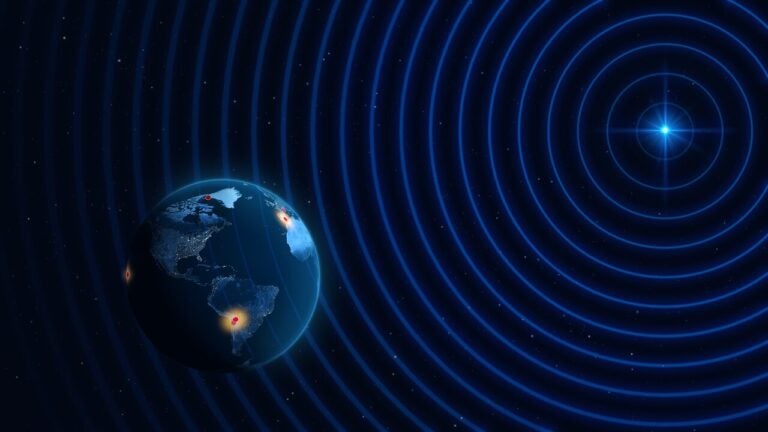Collisions may be scary, but they’re also fascinating, as NASCAR fans can attest. In our celestial neighborhood, physical contact between bodies during our lifetimes involves only small things like comets or their fragments smashing into larger objects like planets. We see the result each night, as meteoroids end their ancient lives with a fiery disintegration through the air.
Star collisions would be far more dramatic, but we’ve never observed a single such event, as a typical sun usually lies about 5 light-years from its nearest companion.
Galaxies are different. These star cities are often so large — 100,000 light-years across — that only 10 galaxy-disks typically separate them from their neighbors. Hence, while stars almost never collide, galaxies definitely do. Indeed, every galaxy probably undergoes at least one collision in its lifetime. The universe is a “bumper car” ride.

Bringing the universe to your door. We’re excited to announce Astronomy magazine’s new Space and Beyond subscription box – a quarterly adventure, curated with an astronomy-themed collection in every box. Learn More >>.
Surrounding our Milky Way, galaxies hover in their own space, threatening no one. Yet everything is in motion — very fast — and the fact that our galaxy and the giant Andromeda Galaxy (M31) approach each other at a closing speed of 70 miles (110 kilometers) every second means that a collision is inevitable. Picture the two galaxies like a pair of footballs on opposite sides of a 25-foot-long (7.6 meters) room. Each football (galaxy) moves its own length every 200 million years. At that rate, the collision will unfold 5 billion years from now.
And then what? What will this violent spectacle look like? Fortunately,we don’t have to guess. At a distance of 45 million light-years, NGC 4038, a normal spiral galaxy, and NGC 4039,a barred spiral galaxy like our own, slammed into each other head-on onlya few hundred million years ago. This resulted in a bizarre slow-motion minuet of tidal warping called the Antennae Galaxies, with gases from the two titanic entities swirling into each other. In wide-field views, enormous tadpole-looking tails arc wildly into intergalactic space, resembling insect antennae, thus giving this violent merger its name. These “tidal tails” were yanked from each galaxy early — perhaps 300 million years ago — and served as the first ominous signs of the impending collision.
The process, a self-operating cosmic laboratory that for astrophysicists is almost too good to be true, offers a three-ring circus of simultaneous violence. First, the cores of the two galaxies, which narrowly missed each other during the initial collision, now swing around like an amusement park ride. Whipped ever-closer by gravity, they’ll collide and merge in less than 400 million years. Computer simulations show that the result will be a huge elliptical galaxy with a single core composed of a jumble of both galaxies’ members.
No future astronomer will likely guess that spiral galaxies were part of the picture. Those beautiful nautilus designs, already distorted, will be erased forever. But no stars will actually touch. They’re each too far from their neighbors. Merging galaxies merely pass through each other, the invisible fingers of gravity doing the sculpting.
Next, there’s all the dusty hydrogen gas, a major component of spiral galaxies. We vividly see all this dusty gas mixing violently to form vast, dark, chaotic molecular clouds, blocking the intense light behind them. Meanwhile, some of the merging hydrogen condenses into vast assemblies of new sun birth. We’re watching billions of stars forming simultaneously, many creating giant blue “super star clusters” that will probably become globular clusters like the 150 spherical star cities surrounding our Milky Way.
This is the nearest and youngest example of colliding galaxies where we can see each component clearly; its proximity lets us study its starburst activity in peeping-Tom detail. Many of the Antennae’s faint cobalt blotches are young clusters with tens of thousands of massive new baby suns apiece. The pink or red spots popping up chaotically are the campfires of excited hydrogen, HII regions (large clouds of ionized gas) where even more new stars are hatching, their fierce ultraviolet energy lighting up each gaseous embryonic matrix. Finally, the two giant yellow-orange blobs are the cores of the ill-fated original galaxies NGC 4038 and 4039. They still contain the original old stars whose planetary life, if any, must be astonished at the frozen violence that now totally fills their sky horizon to horizon.
For astronomers, the overall structure of both Antennae members is gold. Using computers to create animations of two interacting spiral galaxies, with separate simulations for varying amounts of invisible “dark matter,” they can determine how much unseen material must be present to fashion the precise shapes we’re now seeing. The result? There is four or five times more dark matter than visible material — not 10 times more as many had believed.
Altogether, the Antennae Galaxies offer a movie preview, a trailer, showing what humans won’t be around to observe themselves 5 billion years from now: the visual aftermath of our galaxy’s collision with Andromeda.


![The Antennae (NGC 4038 [top] and NGC 4039) is a pair of interacting galaxies in the constellation Corvus the Crow.](https://www.astronomy.com/wp-content/uploads/sites/2/2023/02/Antennae.jpg)








